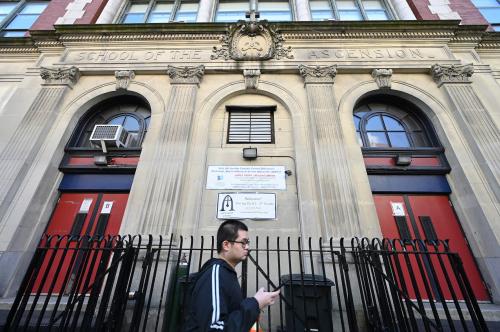For years, economists and pundits pointed to Australia’s generous student loan program as a model for reform in the U.S.1 But late last year, Australia revamped its program over warnings of a cost blow out.2 This major development has received little attention among policymakers in the U.S. Yet it offers important lessons, particularly as government watchdogs are raising alarm over unexpected costs in the U.S. loan program. It turns out, the events in both countries are related.
It started about a decade ago when the U.S. followed the advice of economists and provided students with income-based repayment plans like in Australia – albeit with more modest benefits. Initial estimates pegged the cost at $180 million a year.3 Then the Obama administration supercharged the program, cutting borrowers’ payments by a third and offering loan forgiveness after 20 years, rather than 25. That put benefits closer to Australian levels and even exceeded them for higher earners with graduate school debt. As a result, enrollment in the program has surged, and the Department of Education now says annual costs are $11.5 billion.4
That has prompted a number of lawmakers in the U.S. to propose reforms. The Education and Workforce Committee in the House of Representatives and the Trump administration have offered plans to reduce the cost of the program.5 In a nod to the merits of the program, however, the proposals all maintain the ability for borrowers to make payments linked to their incomes. The big changes would come from cutting loan forgiveness benefits, particularly for graduate students. Such a fix might have some bipartisan appeal. Even the Obama administration came around to the view that benefits in the program needed to be better targeted in the case of loan forgiveness for graduate students.6
What caused the U.S. income-based repayment program to grow much larger than many experts expected? That is where the Australia case is instructive.
Australia created its innovative loan program in 1989 to complement a plan to charge tuition at public universities. While acclaimed for linking payments to income, the program’s other benefits give it extra appeal with some U.S. reformers. Borrowers pay a low interest rate equal to inflation and are exempt from payments until they earn AU$55,874 (US$36,850).7Once a borrower’s income exceeds the threshold, he owes a flat percentage of all his income (i.e., first dollar) toward the loan that year. This rate increases as a borrower’s income rises, creating a progressive repayment structure.
Unlike in the U.S., there is no loan forgiveness after a set number of payments. Loans are generally available for the full tuition price, and because of the subsidized terms, many students opt to take them.
The figure below compares the income-based payment schedule for Australian and U.S. loans. Australian dollars have been converted using a Purchasing Power Parity (PPP) index rather than a straight exchange rate. The PPP index provides a measure of how much an Australian dollar buys in the U.S. and is thus more comprehensive than a simple exchange rate.8 As shown in the figure, both the Australian and U.S. systems exempt borrowers from payments below a threshold and the required monthly payments increase as a borrower’s income rises. The figure also illustrates that the Australian system in place prior to 2018-2019 provided the largest exemption before borrowers were require to make payments.
That Australia’s generous system did not instantly bankrupt itself is partly due to the fact that graduates tended to earn high wages, repaying much of their debts quickly. Furthermore, bachelor’s degree holders typically earned above the exemption, which was pegged to average earnings for all workers. But something else also kept the system afloat that is in contrast to the U.S. approach: Australia limited who could receive loans. Though Australia never means tested its loans, lending was limited in other ways. For example, the government capped the number of university seats, which made admissions more competitive and restricted access to more academically qualified students. Those students who secured a slot had higher graduation rates and were likely to pursue full-time work.9 Moreover, loans were restricted to four-year degrees and advanced programs.
This started to change around 2009 when Australia made two major policy changes. First, fearing the country was falling behind in producing graduates, lawmakers removed enrollment caps at public universities to let them enroll as many students as they wanted.10 Second, students at vocational colleges were given open access to the loan program, a move that led dubious providers to enter the market. Enrollment and borrowing surged.11 More importantly, the population of students who took out loans now looked more like those in the U.S. – more varied and less elite.
These changes may have contributed to lower wages among borrowers, along with other demographic and labor market shifts. For example, vocational students tend to earn less than bachelor’s degree students, and they are more likely to drop out with debt before completing.12 The repayment exemption in the loan program, which seemed relatively low when the program was limited to bachelor’s degree holders, is relatively high for what these borrowers earn. Many of them will therefore not earn enough to repay their debt. Additionally, it is becoming more common for graduates to work part time. In the 1990s, about 20 percent of graduates worked part-time, but that figure has steadily increased to 25 percent.13 Part-time workers are less likely to exceed the income exemption and repay their debt. (Payments are based only on a borrower’s personal income, not household income). Those trends, combined with a flood of new borrowers, meant the loan program was headed for a cost blowout.14
Unlike Australia, the U.S. has long maintained an effectively open-access higher education system, and all students have been eligible for federal loans since the early 1990s, including for short-term credentials at community colleges and for-profit institutions. But its loans were never as subsidized as Australia’s. They worked like mortgages and charged interest well above inflation. Those features are not ideal for student loans given that borrowers need more flexibility in repayment, which is why income-based repayment is a sensible solution.
When the U.S. added a widely-available income-based repayment option in 2007 and increased the benefits in 2010, it was able to avoid the same challenges as Australia for one key reason. The program, even in its current, more generous form, still requires many borrowers to make higher monthly payments than borrowers in Australia if they earn low and middle incomes. And the income deduction is lower in the U.S., meaning borrowers must begin making payments at lower income levels. This keeps costs down for the government by creating a broad base of borrowers who are repaying their loans. Cost pressures in the U.S. program stem instead from generous loan forgiveness terms for high-debt graduate students – a problem compounded by the relatively low payments they are required to make even when their incomes are high (see figure above).15
The U.S. program ended up with such high costs because it gave students with very different debt situations – undergraduate and graduate students – the same repayment terms under income-based repayment. At current benefit levels the program works well for typical undergraduate debts, but is costly when provided to larger graduate debts. In Australia’s case, a policy that was fiscally sustainable when provided to a limited number of bachelor’s degree students became unsustainable when enrollment caps were removed at universities and loans were extended to vocational education programs.
Australia recently took action to put its loan program on a more sustainable path. First, lawmakers reduced the income exemption from AU$55,874 to AU$45,000 (US$36,856 to US$29,683) to make more borrowers liable for repayment.16 Upper income borrowers are required to make higher payments as well, which is shown in the figure above. In addition, the income brackets that dictate a progressive payment structure will now increase more slowly, raising payments over time. These changes are retroactive, meaning the new terms will apply to outstanding debt and new borrowers. Lastly, lawmakers imposed tighter standards on vocational education providers and lower loan limits for their students.
Unlike in Australia, U.S. policymakers have yet to agree on what should be done to address the problems in the income-based repayment program, or if there is even a need for action. It is time for the economists and pundits who were pointing to Australia earlier to hold the country up as a model again. Smart reforms to the income-based repayment program are needed to save this important program from sinking under its own weight.
The authors did not receive any financial support from any firm or person for this article or from any firm or person with a financial or political interest in this article. They are currently not an officer, director, or board member of any organization with an interest in this article.
-
Footnotes
- Joseph E. Stiglitz, “Student Debt and the Crushing of the American Dream,” New York Times, May 12, 2013, https://opinionator.blogs.nytimes.com/2013/05/12/student-debt-and-the-crushing-of-the-american-dream/.
- Dan Conifer and Michael McKinnon, “University, Vocational Training Debts to Skyrocket Costing Budget Billions, Documents Show,” ABC News, April 6, 2016,www.abc.net.au/news/2016-04-06/higher-education-debts-to-skyrocket-costing-budget-billions/7302062; Australian Government, “Improving the Sustainability of Higher Education,” Higher Education Reform Package, https://docs.education.gov.au/system/files/doc/other/45k_hybrid_threshold_cpi_indexation_lp_0.pdf.
- Congressional Budget Office, “H.R. 2669 College Cost Reduction Act of 2007,” June 25, 2007, www.cbo.gov/sites/default/files/110th-congress-2007-2008/costestimate/hr26691.pdf.
- Department of Education, “The Department’s Communication Regarding the Costs of Income-Driven Repayment Plans and Loan Forgiveness Programs,” Office of Inspector General, January 31, 2018, www2.ed.gov/about/offices/list/oig/auditreports/fy2018/a09q0003.pdf.
- Committee on Education and the Workforce “PROSPER Act,” https://edworkforce.house.gov/prosper/; The White House, “Fiscal Year 2019: Efficient, Effective, Accountable An American Budget” www.whitehouse.gov/wp-content/uploads/2018/02/budget-fy2019.pdf.
- Department of Education, “Student Loan Overview Fiscal Year 2015 Budget Review,” www2.ed.gov/about/overview/budget/budget15/justifications/s-loansoverview.pdf.
- Australian dollars are converted using 2017 Purchasing Power Parities (PPP).
- Figures in Australian dollars are converted into U.S. dollars at purchasing power parity (PPP). A PPP adjustment accounts not only for the exchange rate between two currencies, but for differences in price levels across countries. Adjusting for PPP allows us to compare income levels in two countries adjusted for the different cost of living in those countries, whereas a simple exchange-rate conversion would overstate the value of a particular income level in a high-price country and vice versa. As the focus of this analysis is to compare how student loan payments between the U.S. and Australia for borrowers of particular income levels, it is important to adjust for PPP to ensure those income levels represent a comparable standard of living. For more information see OECD, “Purchasing Power Parities (PPP),” https://data.oecd.org/conversion/purchasing-power-parities-ppp.htm.
- David Kemp and Andrew Norton, “Review of the Demand Driven Funding System,” https://docs.education.gov.au/system/files/doc/other/review_of_the_demand_driven_funding_system_report_for_the_website.pdf.
- Denise Bradley, et al., “Review of Australian Higher Education: Final Report [Bradley Review]” NCVER www.voced.edu.au/content/ngv%3A32134; David Kemp and Andrew Norton, “Review of the Demand Driven Funding System,” https://docs.education.gov.au/system/files/doc/other/review_of_the_demand_driven_funding_system_report_for_the_website.pdf.
- Universities Australia, “Higher Education and Research Facts and Figures,” November 2015, www.universitiesaustralia.edu.au/australias-universities/info-for-students#.WpbenGfkDj4.
- Andrew Norton, “HELP for the Future: Fairer Repayment of Student Debt,” Grattan Institute, March 2016, https://grattan.edu.au/wp-content/uploads/2016/03/968-HELP-for-the-future1.pdf.
- Andrew Norton, “HELP for the Future: Fairer Repayment of Student Debt,” Grattan Institute, March 2016, https://grattan.edu.au/wp-content/uploads/2016/03/968-HELP-for-the-future1.pdf.
- Parliament of Australia, “Higher Education Loan Programme,” April 2016, www.aph.gov.au/About_Parliament/Parliamentary_Departments/Parliamentary_Budget_Office/Reports/Research_reports/Higher_Education_Loan_Programme.
- Department of Education, “Comparison of Total Originations to the Net Present Value of Payments in Each IDR Repayment Plan: All Borrowers Expected to Enter IDR Repayment in 2016” www2.ed.gov/about/overview/budget/budget17/idrtables.pdf.
- Figures in Australian dollars are converted into U.S. dollars at purchasing power parity (PPP). Department of Education and Training, “Higher Education Reform Package – Student Overview,” Australian Government, www.education.gov.au/higher-education-reform-package-student-overview; Australian Government, “Improving the Sustainability of Higher Education,” Higher Education Reform Package, https://docs.education.gov.au/system/files/doc/other/45k_hybrid_threshold_cpi_indexation_lp_0.pdf.
The Brookings Institution is committed to quality, independence, and impact.
We are supported by a diverse array of funders. In line with our values and policies, each Brookings publication represents the sole views of its author(s).











